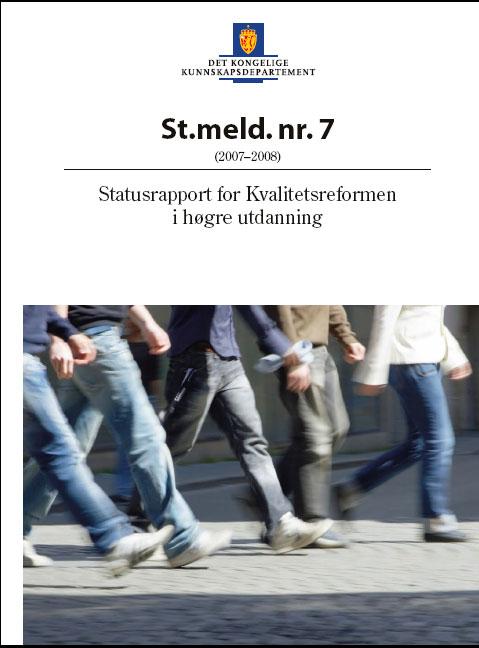A question of quality
The gender equality aspect was missing in the first national evaluation of the Quality Reform. This is evident in the government report on the reform.

In 2003, the Ministers of Science in EU signed a declaration which stated that the Bologna process aims to reduce gender inequalities in higher education.
On the last day of November 2007, four years after this declaration, Minister of Research and Higher Education Tora Aasland presented the first government report on the implementation of Norway’s follow-up of the Bologna process: The Quality Reform.
Despite the EU declaration from 2003 gender and gender equality received little attention in Aasland’s government report.
So far, the Quality Reform’s effects on gender equality have not been addressed in the evaluation. This has on several occasions been criticized by, amongst others, the Committee for Mainstreaming – Women in science (the Kif committee).
Committee leader Gerd Bjørhovde finds it regrettable that we – even after the government report – still lack knowledge of how the reform has affected this area.
"The communiqué from the ministers’ meeting in Berlin clearly states that the reduction of gender inequalities should be addressed in the Bologna process. It is important to follow up on this point," she says.
The Quality Reform was implemented at institutions of higher education in the autumn of 2003. Central elements of the reform are for instance a new degree system, new examination and evaluation practices, increased internationalisation, and new funding and management systems.
Positive effects
Bjørhovde says that it is difficult to assess the reform’s negative or positive effects with regards to gender equality in higher education and research, but she mentions some of the general experiences.
"Higher education continues to attract large numbers of girls and the reform appears to have had a positive effect on the PhD programmes. More and more students defend their dissertation and in the first semester of 2007 47 per cent were women. Tromsø will set a new record in the number of completed PhDs this year and it will be interesting to see what the female ratio is."
According to Bjørhovde, this suggests that a more structured PhD programme has had positive effects on the research scholars, perhaps particularly the women.
However, she is concerned about the reports that researchers now have less time for research.
"It appears as though some of the female researchers feel trapped between devoting time for research and teaching."
Extensive reform
Bjørhovde points out that the Quality Reform is extensive; it not only concerns studies and research, but also areas like funding and institution management. "We don’t know if the changes in management practices have affected the situation regarding gender equality, but it would be interesting to examine this aspect more closely."
In Bjørhovde’s opinion, the Quality Reform’s lack of a gender perspective should be a reminder that the gender equality aspect must be included in all future work within this area.
"Integrating gender perspectives requires a continuous commitment. This is an ongoing process; for instance, a new recruitment report will be presented in Parliament next year. The report is said to include a proper gender equality perspective, and the Kif committee has been asked to submit its comments. This is of course something we appreciate," Bjørnhovde says.
Gender on the agenda
The evaluation of the Quality Reform has not analysed the consequences for the gender equality situation in institutions of higher education. But could the declaration from the Bologna process have been followed up more actively? Could gender and gender equality perspectives to a larger degree have been included in the reform?
Eva Skærbæk is an associate professor at the Faculty of Health and Social Studies at Østfold University College and a member of the Kif committee. She believes that the introduction of the Quality Reform could have been a golden opportunity to include gender equality issues in several study plans.
"Many institutions leave it up to the individual teacher to decide whether they want to address gender and gender equality issues, although these matters are relevant within many academic fields. This affects the quality of the teaching. I don’t understand how we can accept this," she says.
Skærbæk points to the quality assurance systems established by NOKUT (see frame) to ensure the quality of the education at universities and university colleges. Here the criteria that the institutions must meet in order to get their study programmes approved, are listed.
"Criteria concerning the integration of a gender perspective could have been added to remedy the randomness that characterises the teaching," she says.
Grateful to the Quality Reform

Harriet Bjerrum Nielsen, director of the Centre for Transdisciplinary Gender Studies at the University of Oslo, finds Skærbæk’s suggestion interesting.
"That could be a good idea. Gender perspectives are often only recognised when the institution faces consequences if it ignores them. This is something we also see in gender equality work."
However, she wants to emphasise that the Quality Reform has meant a lot in the development of gender studies at the University of Oslo.
"Our experience with the reform is positive. For instance, it has enabled us to establish an interdisciplinary bachelor degree in gender studies," she says.
"Previously, all subjects were like little kingdoms; it was practically impossible for outsiders to change the curriculum. By allowing for interdisciplinary study programmes the reform has made it possible to combine gender studies with other academic disciplines. This way, more students are introduced to gender studies."
Nielsen is certain that some of the interdisciplinary study programmes at the University of Oslo owe their existence to the Quality Reform.
Instrumental
Nielsen adds that the already existing Centre for Gender Studies at the University of Oslo gave them an advantage. This centre was instrumental in the development of new study programmes.
"Without the centre’s efforts to establish these new programmes, nothing would have happened. This shows how important it is to have a centre for gender studies. Many university colleges and universities are in a different position. Some institutions display surprisingly little knowledge about gender studies."
Nielsen is less certain when it comes to possible consequences the reform might have had on gender equality issues. "The Quality Reform is a consequence of the democratisation of higher education. A lot more people get a higher education today; at the same time the elite still receive priority with the extension of the degree system with the PhD level. Girls continue to flock to the universities while the boys are in retreat. But I doubt that that is a result of the reform."
"As far as choice of study programmes concerns, the reform has not changed the traditional gender patterns. However, it is hard to imagine that such a reform could alter something that is so deeply rooted in our culture," says Nielsen.
Translated by Vigdis Isachsen
The Quality Reform is a large-scale reform of Norwegian higher education which was implemented nationwide in the fall of 2003. With the Quality Reform, the Norwegian government has implemented most of the elements from the Bologna Declaration.
The Norwegian Agency for Quality Assurance in Education (NOKUT) is an independent public agency. NOKUT’s task is to assess and improve the quality of Norwegian universities and university colleges.
On September 19 2003, 33 European ministers of higher education convened in Berlin. The purpose of the meeting was to speed up the implementation of the European Higher Education Area. The final report from the meeting emphasised the social dimension of the Bologna process. One of the goals is to reduce gender inequalities both on a national and European level.
From the communiqué:
"The need to increase competitiveness must be balanced with the objective of improving the social characteristics of the European Higher Education Area, aiming at strengthening social cohesion and reducing social and gender inequalities both at national and at European level.”
